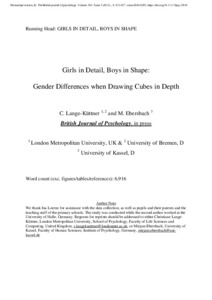| dc.date.accessioned | 2021-08-03T16:02:32Z | |
| dc.date.available | 2021-08-03T16:02:32Z | |
| dc.date.issued | 2013 | |
| dc.identifier | doi:10.17170/kobra-202103253599 | |
| dc.identifier.uri | http://hdl.handle.net/123456789/13070 | |
| dc.description | This is the pre-peer reviewed version of the following article: "Girls in detail, boys in shape: Gender differences when drawing cubes in depth", which has been published in final form at https://doi.org/10.1111/bjop.12010. This article may be used for non-commercial purposes in accordance with Wiley Terms and Conditions for Use of Self-Archived Versions. | eng |
| dc.language.iso | eng | eng |
| dc.rights | Urheberrechtlich geschützt | |
| dc.rights.uri | https://rightsstatements.org/page/InC/1.0/ | |
| dc.subject | three-dimensional cube drawing | eng |
| dc.subject | occlusion | eng |
| dc.subject | gender differences in spatial abilities | eng |
| dc.subject | appearance-reality-distinction | eng |
| dc.subject.ddc | 150 | |
| dc.title | Girls in detail, boys in shape: Gender differences when drawing cubes in depth | eng |
| dc.type | Aufsatz | |
| dcterms.abstract | The current study tested gender differences in the developmental transition from drawing cubes in two‐ versus three dimensions (3D), and investigated the underlying spatial abilities. Six‐ to nine‐year‐old children (N = 97) drew two occluding model cubes and solved several other spatial tasks. Girls more often unfolded the various sides of the cubes into a layout, also called diagrammatic cube drawing (object design detail). In girls, the best predictor for drawing the cubes was Mental Rotation Test (MRT) accuracy. In contrast, boys were more likely to preserve the optical appearance of the cube array. Their drawing in 3D was best predicted by MRT reaction time and the Embedded Figures Test (EFT). This confirmed boys' stronger focus on the contours of an object silhouette (object shape). It is discussed whether the two gender‐specific approaches to drawing in three dimensions reflect two sides of the appearance–reality distinction in drawing, that is graphic syntax of object design features versus visual perception of projective space. | eng |
| dcterms.accessRights | open access | |
| dcterms.creator | Lange‐Küttner, Christiane | |
| dcterms.creator | Ebersbach, Mirjam | |
| dc.relation.doi | doi:10.1111/bjop.12010 | |
| dc.subject.swd | Raumvorstellung | ger |
| dc.subject.swd | Kognitive Entwicklung | ger |
| dc.subject.swd | Geschlechtsunterschied | ger |
| dc.subject.swd | Sozialisation | ger |
| dc.subject.swd | Formenzeichnen | ger |
| dc.subject.swd | Experimentelle Psychologie | |
| dc.type.version | submittedVersion | |
| dcterms.source.identifier | eissn:2044-8295 | |
| dcterms.source.identifier | issn:0007-1269 | |
| dcterms.source.issue | Issue 3 | |
| dcterms.source.journal | The British journal of psychology | eng |
| dcterms.source.pageinfo | 413-437 | |
| dcterms.source.volume | Volume 104 | |
| kup.iskup | false | |

